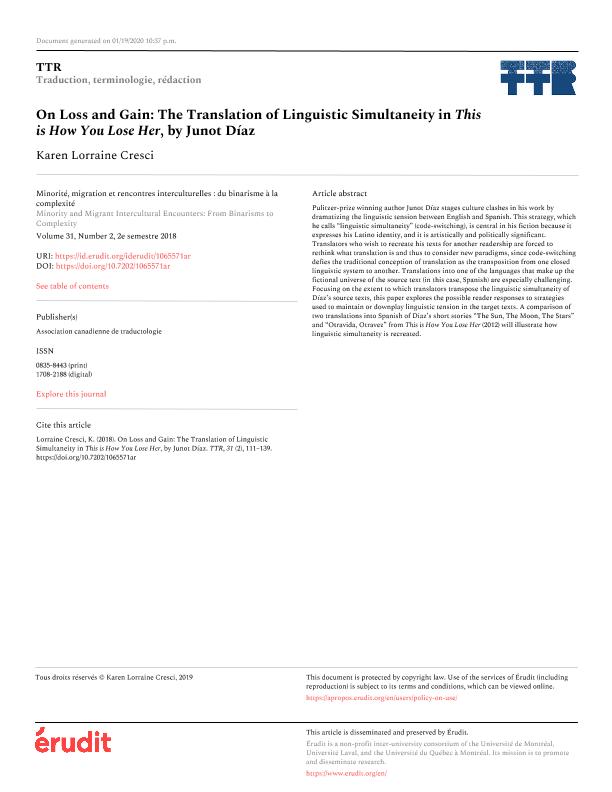Artículo
Pulitzer-prize winning author Junot Díaz stages culture clashes in his work by dramatizing the linguistic tension between English and Spanish. This strategy, which he calls “linguistic simultaneity” (code-switching), is central in his fiction because it expresses his Latino identity, and it is artistically and politically significant. Translators who wish to recreate his texts for another readership are forced to rethink what translation is and thus to consider new paradigms, since code-switching defies the traditional conception of translation as the transposition from one closed linguistic system to another. Translations into one of the languages that make up the fictional universe of the source text (in this case, Spanish) are especially challenging. Focusing on the extent to which translators transpose the linguistic simultaneity of Díaz’s source texts, this paper explores the possible reader responses to strategies used to maintain or downplay linguistic tension in the target texts. A comparison of two translations into Spanish of Diaz’s short stories “The Sun, The Moon, The Stars” and “Otravida, Otravez” from This is How You Lose Her (2012) will illustrate how linguistic simultaneity is recreated. L’auteur Junot Díaz, récompensé par le prix Pulitzer, met en scène dans son œuvre le choc de cultures en accentuant la tension linguistique entre l’anglais et l’espagnol. Cette stratégie, qu’il nomme « simultanéité linguistique » (alternance codique), y est fondamentale, non seulement parce qu’elle exprime son identité latino-américaine, mais aussi parce qu’elle est artistiquement et politiquement significative. Les traducteurs qui souhaitent recréer ses textes pour un autre lectorat sont contraints de repenser la traduction et ainsi de réfléchir à de nouveaux paradigmes, puisque l’alternance codique défie la conception traditionnelle de la traduction, à savoir la transposition d’un système linguistique fermé à un autre. Les traductions dans une des deux langues qui composent l’univers fictionnel du texte source (ici, l’espagnol) posent un réel défi. En mettant en évidence la latitude avec laquelle les traducteurs transposent la simultanéité linguistique des textes sources de Díaz, le présent article explore les réponses possibles du lecteur aux stratégies retenues pour maintenir ou minimiser la tension linguistique dans les textes cibles. Une comparaison de deux traductions en espagnol des nouvelles de Díaz «The Sun, The Moon, The Stars » et «Otravida, Otravez », tirées de This is How You Lose Her paru en 2012, illustrera les stratégies employées par les traducteurs pour recréer la simultanéité linguistique.
On Loss and Gain: The Translation of Linguistic Simultaneity in This is How You Lose Her, by Junot Díaz
Fecha de publicación:
11/2018
Editorial:
Université Laval
Revista:
TTR : Traduction, Terminologie, Rédaction
ISSN:
0835-8443
e-ISSN:
1708-2188
Idioma:
Inglés
Tipo de recurso:
Artículo publicado
Clasificación temática:
Resumen
Palabras clave:
Code-switching
,
Literary translation
,
Junot Diaz
Archivos asociados
Licencia
Identificadores
Colecciones
Articulos(CCT - MAR DEL PLATA)
Articulos de CTRO.CIENTIFICO TECNOL.CONICET - MAR DEL PLATA
Articulos de CTRO.CIENTIFICO TECNOL.CONICET - MAR DEL PLATA
Citación
Cresci, Karen Lorraine; On Loss and Gain: The Translation of Linguistic Simultaneity in This is How You Lose Her, by Junot Díaz; Université Laval; TTR : Traduction, Terminologie, Rédaction; 31; 2; 11-2018; 111-139
Compartir
Altmétricas




